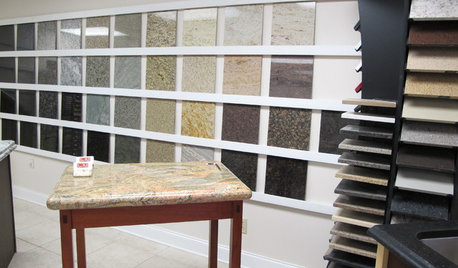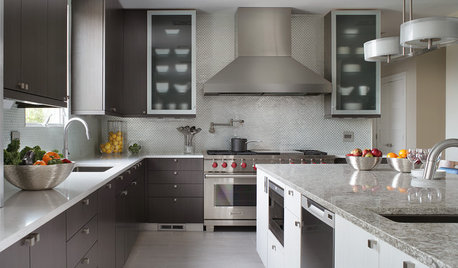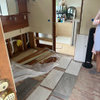Hardwood install issues: dents, no expansion gap
Yesterday my installer started putting in wood floors. As per my other thread, I decided on a diagonal install, and I think it looks great. I don't have any pictures yet (rooms are still too dusty to bring the camera out!), but I will post some when I'm able.
I'm wondering if I had unrealistic expectations about wood floors. I know wood will pick up dents, nicks, and scratches, over time. But in the one room that the installer finished so far, I've found a number of planks with noticeable dents. All told, I found about 4 dents greater than 1/2" long, maybe another 4 between 1/4"-1/2", and many (maybe 20?) smaller dents and nicks. Also a handful of scratches, some greater than 1" long. This is in an area of about 300 sqft.
Is this typical, so I shouldn't worry about it? Is it atypical enough that I should withold the 2nd 1/2 of the payment until the installer replaces the planks with dents? My installer offered to replace a dented plank that is noticeable and right by the room's main entrance. Should I avoid that since the new plank will only be glued down, not nailed? Should I ask the owner of the company to come out and look at the anomalies?
Another thing that seemed strange to me is that many (a majority) of the planks have no expansion gap at all -- the short ends just butt tightly up against the bottom of the drywall. This is mostly in the 2nd room where the less experienced of the two installers has been working.
I don't want to be that annoying customer who complains about trivialities that are an inevitable part of wood floor installations. Then again, maybe it's perfectly legitimate to expect something a little closer to perfection. Please help me calibrate my expectations. :)
Comments (23)
jbranch
14 years agoIf you are not happy, make your thoughts known or you may some day wish you had. I assume you are spending a fair amount of money on this, so speak your mind.
Related Professionals
Dublin Flooring Contractors · Lynbrook Flooring Contractors · Stoughton Flooring Contractors · West Bend Flooring Contractors · Corsicana Tile and Stone Contractors · Turlock Tile and Stone Contractors · Albany General Contractors · Deer Park General Contractors · Elmont General Contractors · Forest Grove General Contractors · Linton Hall General Contractors · Markham General Contractors · Mentor General Contractors · Mount Vernon General Contractors · Newburgh General Contractorsdiy_monger
Original Author14 years agoYeah, I'm spending a lot, and that's why I want to make sure I got what I paid for. I didn't expect 100% perfection, with absolutely pristine planks throughout the whole job; I just didn't expect quite the number of dings that I've seen. I'll give some thought to a good way to convey this to the installer without making them feel defensive from the get-go.
The planks are prefinished. One of the installers was extremely proficient; he finished the largest room much faster than anticipated. My guess is that his speed might have precluded him from giving each plank the inspection I think it deserved.
I should reiterate that on the whole, I'm satisfied. The floors looks really nice, and it wouldn't be the end of the world if I decided to just live with the dents and move on. I know I have an abnormally high level of attention to detail, and that's why I'm reluctant to "make a scene" about issues that might be quite trivial to most people.
jerry_t
14 years agoYour concerns are valid and legitimate. Put a temporary halt to the job and voice your concerns with whomever the boss is.
Boards can come out of a carton dented.... that's fairly rare though and those boards should not get installed unless the damaged area is cut out.. Normally this type of damage comes from sloppy work ethics and factory finished wood being treated too rough..... kicked, stepped on, tossed around, etc.
Question I have..... the installer who is proficient... is there a correlation between the boards in question and the area he installed? ;) Sounds like they are doing all the cutting inside too.
diy_monger
Original Author14 years agoI'll admit I'm ignorant as to how prefinished planks are typically handled. But in my opinion, this installer was a little careless with the planks. He'd drop each box onto the floor rather than set it down -- I'd hear the loud BANG! from 2 stories down each time he got a new box and dropped it. The biggest reason I think he was careless though is that he installed plenty of planks with dents. He can probably install floors 10x faster than I could, but mine wouldn't have dents. :)
Yes, they did the cutting in the house. Is that not typical? The dust is definitely annoying. But given that I had the planks installed on a diagonal, it might have been too much to go outside to cut each one.
jerry_t
14 years agoCutting inside? I hardly ever cut inside but that's just me. What stage of construction are you at right now? In other words have the cabinets been installed, painting completed, the HVAC up and running? I'm getting a mental picture and its not real pretty.
floorguy
14 years agoIf I can, I will set up my cutting area in the last room I will be completing, especially when working upstairs.
More time than not, I do set up on the front or back porch.Plopping a carton down isn't going to cause little dents, unless there is a lot of debris in the cartons.
Dents are caused after the boards are installed(or the tools used during) Workers with hard sole boots, can dent a floor quickly. In and out the door with a small pebble stuck in the tread of a tennis shoe...OUCH.
diy_monger
Original Author14 years agoJerry -
Sorry if something I said was misleading; the floors were installed in my existing/finished home. I ripped up the carpets and had them replaced with hardwood.
floorguy -
In retrospect, I really wish they would have done the cutting out on the front porch instead. The front porch is right off the two rooms that were done downstairs. That would have been more cumbersome for the upstairs hallway, because they would have had to go up and down the stairs for each cut. But the vast majority of the square footage was done downstairs. I'm having a heck of a time cleaning up all the dust. :(
If the dents weren't caused by dropping boxes, then they probably were caused by all the tools as you say. Or the work boots, which were definitely going indoors and outdoors all day long when the installers went to fetch each box of wood.
I guess I'll get over the dents. They're really not egregious, just a little annoying, especially since they likely could have been avoided with a little more care.
The thing that bothers me most though is the installer charged almost 2x the labor rate for the diagonal install, with the explanation that the labor would be much greater to do it that way. Yet it took the exact same time to do the diagonal install as the installer estimated it would take to do a parallel or perpendicular install, and with one fewer workers on one of the days.
I paid for the 1st half of the job upfront, but not yet the 2nd half. Do I have a leg to stand on if I tell the company it's a little underhanded to charge me that much extra for the labor when it didn't apparently take any longer?
jerry_t
14 years ago"Do I have a leg to stand on if I tell the company it's a little underhanded to charge me that much extra for the labor when it didn't apparently take any longer?"
If the estimated cost was based on a diagonal sq.ft. up charge, then that is what it is, an up charge.... regardless of the time it took. I'm having to assume you know going in about the up charge.
diy_monger
Original Author14 years agoJerry -
I knew about the "up charge" beforehand. However, I was told that the increased amount was due to extra labor involved. The extra labor never materialized, and that's the reason I feel the up charge is a bit underhanded.
To put it in perspective, the labor charge came out to $3,000 for a total of about 20 man hours. Does that sound even remotely reasonable?
Or how about this: I paid $150/hour for a level of service that included all the cutting being done inside the house (dust everywhere), a rushed job that resulted in a large number (in my opinion) of dents, and some minor drywall damage. Is that even in the ballpark of the "industry norm", if there is such a thing?
floorguy
14 years agoDon't pull that crap with the installer. Estimated times are just that. What is agreed to for the service provided is all that matters. He told you a price and you agreed. Cut and dry, your legs will get cut off.
diy_monger
Original Author14 years agofloorguy -
Relax, I'm not going to stiff anybody.
Do you charge $150/hour, do your cutting indoors creating a dusty mess, install planks with defects, and leave a bunch of dents? Would you consider any of these to be "pulling crap with the customer?"
diy_monger
Original Author14 years agoLost in the previous conversation was the issue of there being no expansion gap on most of the planks in one room. When I asked the installer about it, he told me in no uncertain terms that an expansion gap is completely unnecessary for nailed down floors, and that it only applies to floating floors. This is 100% contrary to everything else I've read about hardwood installations.
The climate here (northeast) is very humid in the summers, and dry in the winters. The floors were installed over the course of 2 humid days, and the planks were not acclimated to the house first. The house has no air conditioner, though I do run a dehumidifier in the basement during the warmer months.
Is the lack of expansion gap likely to haunt me in the future? Should I insist that the installer to go around the perimeter with a toe-kick saw and "add" an expansion gap? Or is he right in that an expansion gap is unnecessary for pre-finished, stapled-down 3/4" hardwood?
boxers
14 years agoexpansion is so basic for any hardwood installation, yes its required. If its engineered its more stable but the installation technique has not much to do with it. Floating floors move as a panel but glued or nailed will have expanision and contraction in individual boards. Not allowing for expansion can cause problems.
glennsfc
14 years agoI have yet to do a prefinished floor that didn't have a minor blemish somewhere in the uninstalled product, and...yes...some inadvertedly wound up in the finished floor.
Most manufactured products have a blemish here or there. However, my daughter just picked up a 2010 Toyota Prius and I could not find even one blemish or flaw on the exterior or the interior of the thing..just amazing!
I agree with the other poster about services provided.
It is doubtful that the floor is going to buckle...however I bet you'll have some minor gapping in the winter months, although how wood floors behave are determined more by the particular house they're installed in than by the region.
And, as for the acclimation concern, I have found by experience that you can create problems simply by letting wood sit in uncontrolled conditions, such as a house open to the outside humid air or one naturally humid due to what lot it's been built on or to the basic construction itself.
Glad you like your floor.
floorguy
14 years ago"Do you charge $150/hour, do your cutting indoors creating a dusty mess, install planks with defects, and leave a bunch of dents? Would you consider any of these to be "pulling crap with the customer?"
No, I don't charge by the hour. I place a bid on the work. When I bid I bid for worst case scenario. As you never know. So based on the time I feel it is going to take me, I place a price on that. It will never be the same per sq.ft. charge, as no two projects are the same. Depended how I bid it and if it takes less time then I estimated, I could make $150 or even more, an hour, but it usually all averages out to $65 per hour, for me and $100 an hour if I have one helper. The business banks money to stay in business and all overhead is paid, plus buying or repairing tools, and I pay myself a weekly wage, based on the hours I worked that week.
No, when I cut inside, all my saws are hooked to a dust collection system, and I place plastic on the floor under my cutting area. There is some light residual dust, but as I'm prepping that last room, I dust and vacuum window seals, walls and the top of baseboards are all cleaned up.
Planks with defects are culled out and have their own carton by the end of the job. what you may consider a defect, might just be a common characteristic of the wood. Mineral streaks for instance. Some consumers don't want it in their floor, to which I tall them to buy more flooring so I can cull out more wood. Are they happy... NO!
If I dent a board and it has happened to the best of us, that board gets replaced right then and there, so it does not throw a red flag up to you when you see it.But you see, I like several here are not your typical installers. Some of us go over and beyond, as we take great pride in our craft. It isn't just a job to us. That is why I have been told, my pricing is way more then Joe the Butcher.
diy_monger
Original Author14 years agofloorguy -
I think I would have been much happier had you installed my floors. The things you mentioned -- minimizing the dust mess, culling out damaged planks, replacing dented boards -- are all the "right" way to do things in my opinion. That's what a contractor who has pride in his work, and who wants the customer to be satisfied, would do.
By the way, the defects I mentioned are not things like mineral streaks. On some of the planks, there is a concave portion about 1/2" from the short end, so that the very end of the plank is pulled up slightly higher than the abutting plank. It looks like a "smooth dent", if that makes any sense. When I pointed this out to the installer, he said that the finish is stronger than the wood, and when it dries it sometimes pulls the end of the plank up. His solution was to lay another plank over it and smack it with a hammer so the end didn't stick up so far. It's slightly less noticeable afterward, but is still an obvious flaw that has nothing to do with the natural characteristics of the wood.
You also don't sound like the kind of installer who would inadvertently leave many dents. And if you did leave dents, you would probably notice them and replace the dented planks on the spot, rather than either not noticing, or leaving this "surprise" for the customer to discover. Unfortunately the number of significant dents I've come across (at least 3 in every room) have raised a red flag. I asked the installer about the most egregious of the dents, and he admitted he should have noticed that during the install (and offered to replace the plank if it bothered me).
floorguy, do you agree that having those planks cut out and new ones glued back in shouldn't be a problem? There are 5-10 planks total that would need replacement. I'd be mostly concerned that the glue wouldn't hold up as well as glue + staples, so that the plank would be more likely to work loose than the existing dented (but stapled) plank. If glued-in replacement planks are not such a big deal, I will ask the installer to replace all the ones that really bother me.
And finally, what's your take on the expansion gap issue? The poster 'boxers' agreed that leaving an expansion gap is part of Hardwood Floor Installation 101. My installer made it clear that he doesn't think the expansion gap is needed, and that I'm worrying for no good reason. Yet many of the planks are butted right up against the drywall, so that when I walk the perimeter of the room I hear a lot of groaning and squeaking. Should I insist that he come back with a toe kick saw and add the gap? Maybe it would be worth hiring a floor inspector to give my opinion a little added weight?
Thanks for all your replies...you've been a big help!
boxers
14 years agoThe higher ends comes sometimes from the kiln drying process the mill uses. The ends of the boards sometimes dry slightly different than the 'body' of the board leaving the ends a little wider or taller. Tolerance would be about the thickness of a dime.
diy_monger
Original Author14 years agoThanks, boxers! The end being a little taller than the abutting plank is not quite as irritating as the fact that it looks like a big dent. It seems like the installer would/should have removed these planks or at least cut off the 1" on the end with the defect. Perhaps he did for most, but just missed some of them.
canuck88
14 years agoHe's probably causing the dents. Does his hammer have a soft rubberized handle? Often when it's in the belt the handle will bang around on the floor when you are racking
makeshift_designer
13 years agoI'm having similar problems with a recent install in a concrete condo with solid maple over a plywood subfloor. My floor guy completed the job with no expansion gaps and the floor is now buckling and even coming up. After raising the concerns with him, he gave me the following excuses:
- Buckling is expected especially with the "drastic weather changes" in the NYC/NJ area
- UV block should be considered so that we're not "cooking the wood and overexposing it to extreme elements"
- A humidifier/dehumidifier and heater is necessary to maintain a constant humidity and temperature of 70-75 degrees to allow for further acclimation despite acclimation for 2 weeks prior to installI've had the owner of the floor store take a look as well as an architect friend, and contractor friend. They've all said the buckling is due to faulty installation whether it be not enough glue, not enough nails, lack of expansion gap, or some combination of the above and is the responsibility of the installer. Unfortunately, I've given him the last payment so I'm at a bit of a loss at what to do next. I've tried to address my concerns with my floor guy and how they're not just a result of neurosis but he refuses to come take a look.
- How important is an expansion gap in a condo? As is, all the boards are butted to the walls.
- Advice on how to convince him to return would be greatly appreciated as I've exhausted all options thus far.I can provide pictures if it helps so let me know! Thank you in advance for your help.
glennsfc
13 years agoYours is a difficult call. You may need to hire an independent flooring inspector to establish fault.
So...the owner of the floor store has nothing to do with the installer? Who specified the job?
brickeyee
13 years ago"expansion is so basic for any hardwood installation, yes its required."
This is NOT correct.
A solid hardwood floor that is nailed down at one edge of every strip has the expansion gaps built in as the floor is installed.
The expansion occurs on every strip of wood separately, and the edges of each board move separately.
The gaps between boards open and close through out the year as the humidity changes.'Engineered' wood flooring that is glued together moves as a single very large board, and requires significant gaps at the edges.
If the flooring uses cross grain plies, the overall movement will be in two dimensions and a gap is needed on all sides (though not as wide as a non-ply type material).


















boxers